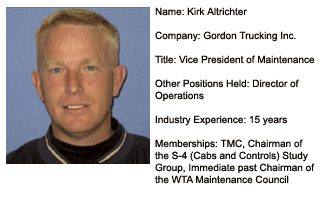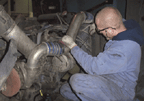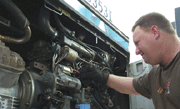It’s not the data, but how it’s used
Gordon Trucking’s Kirk Altrichter applies software and people skills to improve maintenance workflow

Kirk Altrichter brings the perspective of a trucking “ops guy” to his role as Gordon Trucking’s VP of Maintenance, a post he’s held for four years. He now oversees 1400 Class 8 tractors, all of them Freightliners. The oldest have been on the road about four to five years, each with 550,000 to 650,000 miles, on average. Altrichter also maintains about 4000 trailers for the company.
Altrichter’s “best practices” in maintenance include cost and time savings derived from analyzing data “mined” from numerous software packages. “We’ve spent a lot of effort and time on data mining,” says Altrichter. He found that there were many different “bolt-on software packages” in use throughout the company, all good at gathering data, he says, but not always so useful at kicking out meaningful information. Altrichter is in the process of implementing Cognos business intelligence software to pull database information from various sources company-wide, without worrying about compatibility issues from many different software packages. He can generate the information he needs by selecting various alerts that display on a computer screen dashboard. This will give him a real-time look at assets, without the need to search through tons of data. For example, he can select a group of 300 tractors of the same vintage, make and model, and track their performance. He can then ask, “What are we seeing over time? Failures in mileage or within a time-frame? Then we can ask, ‘what can we do on a predictive basis to prevent over-the-road breakdowns?’”
About 50 to 60 percent of shop time is spent doing predictive or preventative maintenance, which will become more efficient by software analysis of when to do it, what parts will be needed and how soon.
One aspect of best practices in keeping track of parts is to reinforce the need with your people to stick with the process and procedures involved. “Bring parts in, you enter them into the system; take parts out, you take them out of your system.” He admits it doesn’t always work that easily, but the goal remains. And it’s not just about running out of parts. “Maintaining inventory is making sure you’re factoring in things such as safety stock, plus lead times for orders, economic order quantities and all the things that go into getting the biggest bang for your buck.”

The benefits of data-mining go beyond predicting parts needs. By tracking with software, the company has been able to measure technician performance versus standard repair times. The data provide ongoing coaching opportunities not only for the technicians, but for their managers. They get feedback from the system not available before on why some tasks take so long to perform. Altrichter credits the more consistent training practice and policy for doing a lot to make sure people learn what they’re supposed to learn. It also has resulted in more consistency across shops. Besides Gordon’s Pacific, Wash. location, there are five other full-service maintenance facilities at Clackamas, Ore, Medford, Ore., Turlock, Calif., Rancho Cucamonga, Calif. and Indianapolis, able to service all of the company’s equipment.
The maintenance facilities have brought another challenge, and that is hiring trained technicians. Depending on geographic location, technicians are getting hard to find. One difficulty, according to Altrichter, is trying to convince young people that being a technician is what they want to do –– a difficult task when they have no prior experience. The number of students who want to work on cars and trucks is declining every year, in part, he believes, because there are fewer school systems able to support trade or vocational education. “I struggle from week to week on how to address the availability of technicians out there.”
Altrichter says the industry needs to change the way it hires and trains technicians. He says the days of dealing with people by ruling with an iron fist are over. “Let people know you care about them; show them that, so they perform at their best.” This is especially important in attracting and retaining good technicians in today’s employment marketplace.

For hiring technicians, Altrichter makes sure the prospective employee is a good fit for the team already in place. “For teamwork reasons, a person lacking people skills can create havoc behind the scenes with other personnel, and that creates extra work.” Given the choice of hiring someone technically proficient but with no people skills –– or someone mechanically inclined who can get along with others –– he’ll select the latter. “Surround yourself with good people, and a lot of little things you spend a lot of time on now, you won’t spend much time on later.” As a manager, Altrichter observes, “A lot is how you treat people. I’m a firm believer in the saying ‘people don’t quit companies, they quit leaders.’” Most gripes are about lack of leadership. He asks, “Think of your own experience. Did you quit the company or quit the boss because they didn’t represent you or take care of you?”
